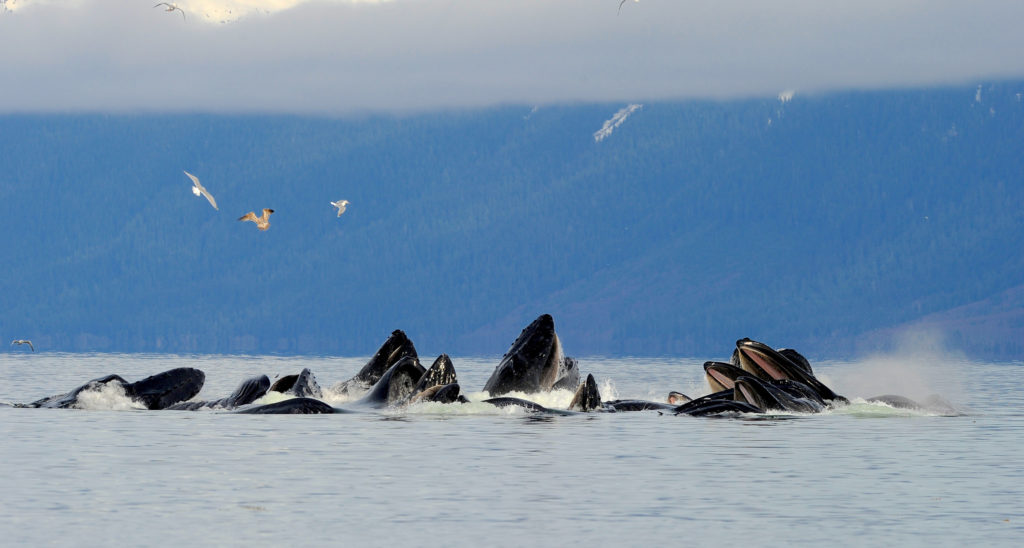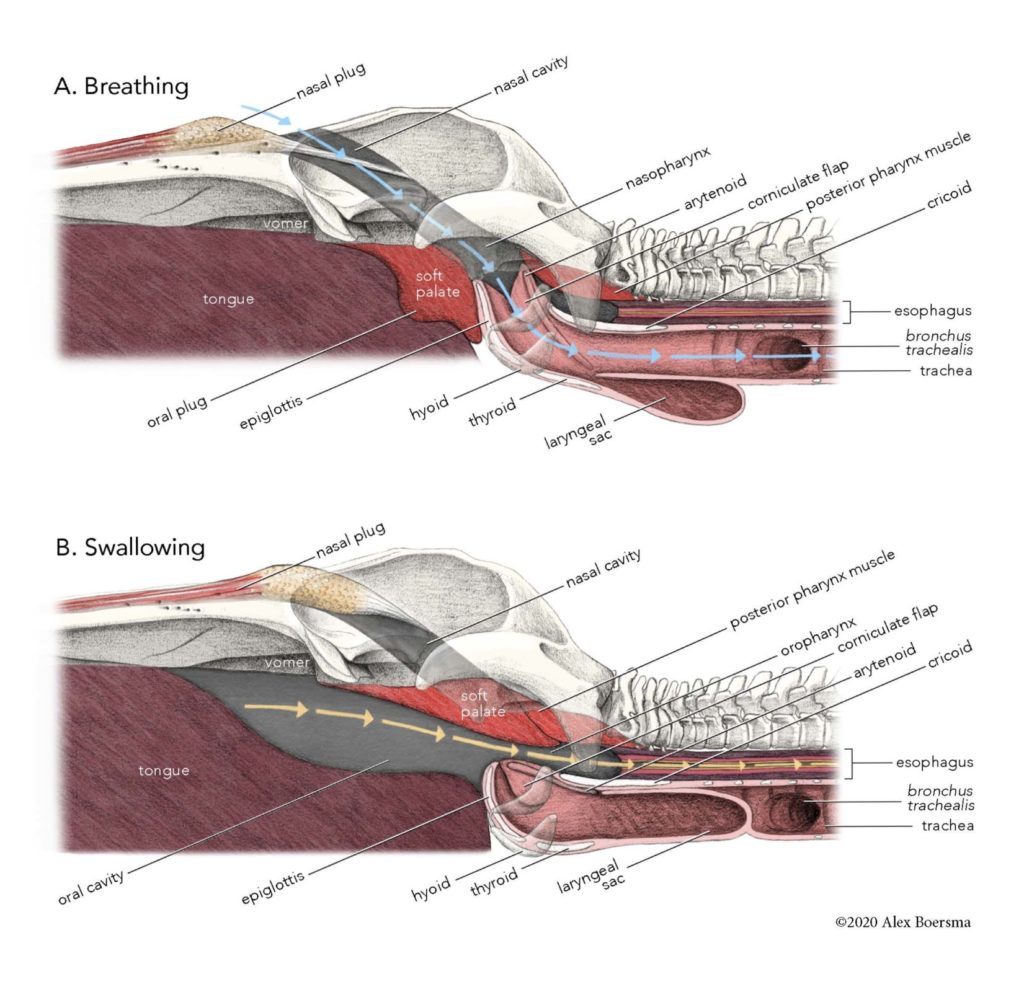Science
Here's why whales don't drown when they gulp down food underwater – UBC News

Ever wondered whether whales can burp, and why they don’t drown when they gulp down gallons of water and krill? New UBC research may just hold the answer.
Researchers found that lunge-feeding whales have an ‘oral plug’, a fleshy bulb in their mouths that moves backwards to seal off the upper airways during feeding, while their larynx closes to block the lower airways.
This plug prevents water from entering their lungs when they feed, according to a paper published today in Current Biology. “It’s kind of like when a human’s uvula moves backwards to block our nasal passages, and our windpipe closes up while swallowing food,” says lead author Dr. Kelsey Gil, a postdoctoral researcher in the department of zoology.
Lunge-feeding whales eat by, you guessed it, lunging at their prey, accelerating at high speed and opening their mouths to engulf water and krill. Sometimes this amount can be larger than their own bodies, says Dr. Gil, an impressive feat given this group includes the humpback and the blue whale, the largest animal on Earth. Water is then drained via their baleen, leaving the tiny, tasty krill behind to be swallowed.
A group of humpback whales in Alaska, near Sitka. Credit: Ari Friedlaender


Credit: Alex Boersma/Current Biology
The researchers investigated fin whales specifically, a type of lunge-feeding whale and found the ‘oral plug’ needed to move in order to allow food to pass to the esophagus. The only way it could was towards the back of the head, and up, blocking off the nasal passages when the whale swallows. Simultaneously, cartilage closes at the entrance to the larynx, and the laryngeal sac moves upwards to block off the lower airways, says Dr. Gil. “We haven’t seen this protective mechanism in any other animals, or in the literature. A lot of our knowledge about whales and dolphins comes from toothed whales, which have completely separated respiratory tracts, so similar assumptions have been made about lunge-feeding whales.”
It turns out humans have a similar system to swallow food without getting anything in their lungs: we have the epiglottis and soft palate, a ‘lid’ of cartilage and a flap of muscle in our throat and mouth, respectively. Humans could probably eat underwater as well, says Dr. Gil, but it would be rather like swimming at high speed towards a hamburger and opening your mouth wide as you approached – difficult not to flood your lungs.
The whales’ oral plug and closing larynx is central to how lunge-feeding evolved, a key component in the enormous size of these creatures, the researchers say. “Bulk filter-feeding on krill swarms is highly efficient and the only way to provide the massive amount of energy needed to support such large body size. This would not be possible without the special anatomical features we have described,” says senior author Dr. Robert Shadwick, a professor in the UBC department of zoology.
Investigating whale anatomy often involves trying to dissect whales that have died from stranding which comes with such challenges as trying to complete work before the tide rises. However, for this research, Dr. Gil and her colleagues dissected whales in Iceland in 2018, recovering tissue that wasn’t being used for food from a commercial whaling station. Working with whales in real-time would be wonderful, she says, but might require some advancements in technology. “It would be interesting to throw a tiny camera down a whale’s mouth while it was feeding to see what’s happening, but we’d need to make sure it was safe to eat and biodegradable.”
The team will continue to explore the mechanisms related to the pharynx, and of the small esophagus that is responsible for rapidly transporting hundreds of kilograms of krill to the stomach in less than a minute. With the many human impacts that disrupt food chains, and knowing how whales feed and how much they eat, it’s good to know as much as possible about these animals in order to protect them and their eco systems, says Dr. Gil.
And there’s plenty more to find out, including whether whales cough, hiccup, and yes, burp. “Humpback whales blow bubbles out of their mouth, but we aren’t exactly sure where the air is from – it might make more sense, and be safer, for whales to burp out of their blowholes.”
Interview language(s): English (Gil, Shadwick)
Science
SpaceX sends 23 Starlink satellites into low-Earth orbit


|
|
April 23 (UPI) — SpaceX launched 23 Starlink satellites into low-Earth orbit Tuesday evening from Space Launch Complex 40 at Cape Canaveral Space Force Station in Florida.
Liftoff occurred at 6:17 EDT with a SpaceX Falcon 9 rocket sending the payload of 23 Starlink satellites into orbit.
The Falcon 9 rocket’s first-stage booster landed on an autonomous drone ship in the Atlantic Ocean after separating from the rocket’s second stage and its payload.
The entire mission was scheduled to take about an hour and 5 minutes to complete from launch to satellite deployment.
The mission was the ninth flight for the first-stage booster that previously completed five Starlink satellite-deployment missions and three other missions.





Science
NASA Celebrates As 1977’s Voyager 1 Phones Home At Last


|
|
Voyager 1 has finally returned usable data to NASA from outside the solar system after five months offline.
Launched in 1977 and now in its 46th year, the probe has been suffering from communication issues since November 14. The same thing also happened in 2022. However, this week, NASA said that engineers were finally able to get usable data about the health and status of its onboard engineering systems.
Slow Work
Fixing Voyager 1 has been slow work. It’s currently over 15 billion miles (24 billion kilometers) from Earth, which means a radio message takes about 22.5 hours to reach it—and the same again to receive an answer.
The problem appears to have been its flight data subsystem, one of one of the spacecraft’s three onboard computers. Its job is to package the science and engineering data before it’s sent to Earth. Since the computer chip that stores its memory and some of its code is broken, engineers had to re-insert that code into a new location.
Next up for engineers at NASA’s Jet Propulsion Laboratory in California is to adjust other parts of the FDS software so Voyager 1 can return to sending science data.
Beyond The ‘Heliopause’
The longest-running and most distant spacecraft in history, Voyager 1, was launched on September 5, 1977, while its twin spacecraft, Voyager 2, was launched a little earlier on August 20, 1977. Voyager 2—now 12 billion miles away and traveling more slowly—continues to operate normally.
Both are now beyond what astronomers call the heliopause—a protective bubble of particles and magnetic fields created by the sun, which is thought to represent the sun’s farthest influence. Voyager 1 got to the heliopause in 2012 and Voyager 2 in 2018.
The Pale Blue Dot is a photograph of Earth taken Feb. 14, 1990, by NASA’s Voyager 1 at a distance of … [+]
NASA/JPL-Caltech
Pale Blue Dot
Since their launch from Cape Canaveral, Florida, aboard Titan-Centaur rockets, Voyager 1 and Voyager 2 have had glittering careers. Both photographed Jupiter and Saturn in 1979 and 1980 before going their separate ways. Voyager 1 could have visited Pluto, but that was sacrificed so scientists could get images of Saturn’s moon, Titan, a maneuver that made it impossible for it to reach any other body in the solar system. Meanwhile, Voyager 2 took slingshots around the planets to also image Uranus in 1986 and Neptune in 1989—the only spacecraft ever to image the two outer planets.
On February 14, 1990, when 3.7 billion miles from Earth, Voyager 1 turned its cameras back towards the sun and took an image that included our planet as “a mote of dust suspended in a sunbeam.” Known as the “Pale Blue Dot,” it’s one of the most famous photos ever taken. It was remastered in 2019.





Science
NASA hears from Voyager 1, the most distant spacecraft from Earth, after months of quiet
|
|
CAPE CANAVERAL, Fla. (AP) – NASA has finally heard back from Voyager 1 again in a way that makes sense.
The most distant spacecraft from Earth stopped sending back understandable data last November. Flight controllers traced the blank communication to a bad computer chip and rearranged the spacecraft’s coding to work around the trouble.
NASA’s Jet Propulsion Laboratory in Southern California declared success after receiving good engineering updates late last week. The team is still working to restore transmission of the science data.
It takes 22 1/2 hours to send a signal to Voyager 1, more than 15 billion miles (24 billion kilometers) away in interstellar space. The signal travel time is double that for a round trip.
Contact was never lost, rather it was like making a phone call where you can’t hear the person on the other end, a JPL spokeswoman said Tuesday.
Launched in 1977 to study Jupiter and Saturn, Voyager 1 has been exploring interstellar space – the space between star systems – since 2012. Its twin, Voyager 2, is 12.6 billion miles (20 billion kilometers) away and still working fine.





-



 Health15 hours ago
Health15 hours agoRemnants of bird flu virus found in pasteurized milk, FDA says
-
Art21 hours ago
Mayor's youth advisory council seeks submissions for art gala – SooToday
-



 Health19 hours ago
Health19 hours agoBird flu virus found in grocery milk as officials say supply still safe
-



 Investment19 hours ago
Investment19 hours agoTaxes should not wag the tail of the investment dog, but that’s what Trudeau wants
-
News20 hours ago
Peel police chief met Sri Lankan officer a court says ‘participated’ in torture – Global News
-



 Science23 hours ago
Science23 hours agoiN PHOTOS: Nature lovers celebrate flora, fauna for Earth Day in Kamloops, Okanagan | iNFOnews | Thompson-Okanagan's News Source – iNFOnews
-
Media14 hours ago
Vaughn Palmer: B.C. premier gives social media giants another chance
-
Art20 hours ago
An exhibition with a cause: Montreal's 'Art by the Water' celebrates 15 years – CityNews Montreal




